Le guide ultime de la décantation de parfum en toute sécurité pour les grands voyageurs
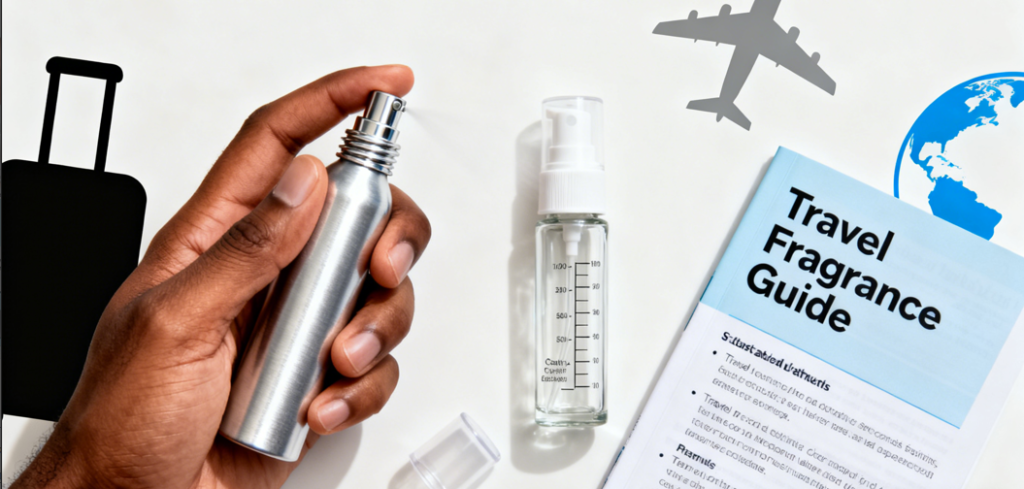
Le guide ultime de la décantation de parfum en toute sécurité pour les grands voyageurs Pourquoi faut-il décanter les parfums en voyage ? Les grands voyageurs d'affaires et les vacanciers préfèrent toujours que leurs bagages soient aussi légers que possible. Cependant, les amateurs de parfums ne peuvent imaginer se passer de leurs fragrances préférées. Parfois, un voyage peut durer une semaine, voire un mois, ce qui nécessite différents parfums pour diverses occasions. Les flacons de parfum de grande taille sont sensiblement lourds, et ceux de plus de 100 ml risquent de ne pas passer les contrôles de sécurité des compagnies aériennes. En outre, les grands flacons en verre sont susceptibles de se briser dans les bagages enregistrés. C'est là que les atomiseurs de parfum portables deviennent essentiels. Ces atomiseurs sont disponibles en petites contenances, comme 5 ml, 8 ml et 10 ml. Leur coque est généralement fabriquée en aluminium robuste et résistant aux chutes, tandis que l'intérieur est en verre borosilicaté, connu pour sa stabilité et ses propriétés non réactives avec le parfum. Équipés d'embouts de brumisation fine, ils garantissent une diffusion complète et efficace des molécules de parfum. Choisir la bonne carafe à parfum : Matériau et structure Actuellement, il existe trois principaux types de carafes sur le marché, le verre étant le plus courant, suivi du plastique. Le métal est principalement utilisé pour l'enveloppe extérieure, qui protège le récipient intérieur en verre. Carafes à parfum en verre : Elles présentent de nombreux avantages : elles sont stables, très transparentes pour une sensation de qualité supérieure, peu susceptibles de réagir avec le parfum et très abordables. L'inconvénient est évident : elles sont très fragiles pendant le transport. Le déballage nécessite des précautions pour éviter d'éventuelles coupures dues à des bris de verre, et le verre moulé a tendance à être plus lourd. Carafes en plastique : Elles sont également très répandues. Elles sont légères, incassables et très bon marché. Leurs inconvénients sont leur manque de respect de l'environnement et leur perception non premium, ce qui les rend moins populaires dans les marchés développés comme l'Europe, les États-Unis et l'Australie. Leurs principaux marchés se situent en Asie, en Amérique du Sud et en Afrique. Atomiseurs à coque en aluminium et intérieur en verre : L'essor de ces atomiseurs est lié à la tendance des parfums par abonnement, qui a stimulé la popularité des carafes de voyage portables. La coque en aluminium offre une sensation de qualité supérieure et permet des designs complexes, idéaux pour les marques de niche et émergentes à la recherche d'une identité unique. Ce type de carafe n'a pratiquement aucun défaut, si ce n'est un coût plus élevé que les carafes en plastique ou en verre. En général, les coûts d'emballage représentent moins de 1% du prix de vente d'un parfum, ce qui incite de nombreux clients à opter pour nos carafes atomiseurs de parfum en aluminium de qualité supérieure. Comment distribuer le parfum correctement et en toute sécurité ? L'objectif de la décantation de parfum est de rendre le transport de votre parfum plus pratique et plus sûr pour les voyages, les trajets quotidiens ou les recharges. Cependant, une mauvaise utilisation peut entraîner des fuites, une évaporation, une contamination ou une altération du parfum. Vous trouverez ci-dessous la méthode de transvasement la plus sûre et la plus standard, qui convient à la plupart des parfums et des carafes de voyage (y compris l'atomiseur de parfum EBI). PréparationAvant de commencer, préparez les éléments suivants : Flacon de parfum original Flacon de carafe vide Lingettes alcoolisées / serviettes en papier Petit entonnoir / tube fin (si vous utilisez la méthode de l'entonnoir)Remarque : Veillez à ce que la surface de travail soit propre pour éviter tout contact avec la poussière ou d'autres odeurs. Nettoyage et désinfection de la carafe Essuyez le goulot de la carafe, le bec et la surface extérieure du récipient intérieur avec une lingette imbibée d'alcool. Si vous réutilisez une carafe, nettoyez-la avec de l'alcool et laissez-la sécher complètement à l'air libre. Veillez à ce qu'il ne reste aucun résidu de parfum ou de liquide provenant d'un parfum précédent. Cela permet d'éviter le mélange des senteurs, la prolifération des bactéries et l'altération du parfum. Méthode 1 : Remplissage par le bas (la plus propre et la plus sûre)Convient aux carafes dotées d'un système de remplissage par le bas, comme celles proposées par EBI : Alignez le mécanisme de fond de la carafe avec la tête de pulvérisation de la bouteille d'origine. Appuyez verticalement pour permettre au parfum d'être aspiré dans le récipient intérieur. Chaque pression permet d'aspirer environ 0,1-0,2 ml. Remplissez le flacon jusqu'à la capacité 80-90% afin d'éviter les fuites dues aux variations de pression atmosphérique. Une fois le récipient rempli, fermez bien le bouchon inférieur. Méthode 2 : Transfert par pulvérisation ou méthode de l'entonnoir (méthode universelle traditionnelle)Convient aux carafes sans système de remplissage par le bas : Retirez le vaporisateur du flacon de parfum d'origine (si possible). Orientez le vaporisateur ou utilisez un entonnoir dans l'ouverture de la carafe. Vaporisez doucement plusieurs fois dans la carafe. Après la décantation, essuyez le goulot du flacon pour éliminer tout résidu extérieur. Serrez fermement tous les bouchons, en veillant à ce que tous les raccords soient étanches. Test d'étanchéitéToujours effectuer un test d'étanchéité après la décantation : Assurez-vous que toutes les parties de la carafe sont bien fermées. Retournez doucement la carafe et secouez-la pendant 2 à 3 secondes. Vérifiez qu'il n'y a aucun signe de fuite ou que la buse n'est pas desserrée. En cas de fuite, rouvrez la carafe et vérifiez les joints et les raccords. Conseils de stockage et de transport Placez le produit dans le sac transparent pour liquides de votre bagage à main afin de faciliter les contrôles de sécurité. Évitez de le placer au fond de votre valise pour éviter qu'il ne s'écrase. Évitez la lumière directe du soleil et les températures élevées (elles peuvent dégrader le parfum). L'atomiseur de parfum EBI, conçu pour les voyages et les collaborations avec des marques haut de gamme, est étanche, résistant aux chutes, personnalisable et doté de multiples structures brevetées, telles que le système de remplissage par le bas, ce qui garantit l'expérience de transvasement la plus pratique et la plus propre. Contrôles de sécurité et conseils de voyage (applicables aux voyages d'affaires et de vacances) La façon dont vous transportez votre carafe à parfum pendant le voyage est cruciale pour le bon déroulement des contrôles de sécurité et la sécurité d'utilisation. Il est généralement recommandé de transporter de petites carafes (≤10ml) dans votre bagage à main. Non seulement elles sont légères et pratiques, mais elles respectent également les restrictions strictes imposées par les compagnies aériennes en matière de liquides. Tous les liquides doivent être placés ensemble dans un sac transparent et refermable pour une inspection rapide, évitant ainsi des contrôles supplémentaires. Pour les vols long-courriers ou les voyages dans plusieurs villes, il est conseillé d'emporter une carafe supplémentaire en cas de changement de pression ou de perte accidentelle. Conservez la carafe dans un endroit facilement accessible et non écrasé de votre sac pour éviter que l'embout ne se desserre ou ne fuie sous l'effet de la pression exercée par d'autres objets. À l'inverse, il n'est pas recommandé de placer le parfum dans les bagages enregistrés en raison du risque de casse lors de la manipulation. Avec des méthodes de transport appropriées, votre parfum peut voyager en toute sécurité, permettant des retouches gracieuses et sans effort tout au long de votre voyage. Recommandations pour les cas d'utilisation des grands voyageurs Pour les grands voyageurs d'affaires et les globe-trotters, le transport d'une carafe à parfum de haute qualité peut considérablement améliorer l'expérience globale. Une recharge rapide de parfum avant un vol, pendant une escale ou avant une réunion importante permet de maintenir une présence fraîche et de renforcer la confiance en soi. Les changements de climat et d'humidité pendant le voyage peuvent accélérer la dissipation des parfums, en particulier dans les régions chaudes ou sèches.
Pourquoi ont-ils commandé d'urgence des tubes de déodorants personnalisés ?

Le choix de 527 acheteurs : Pourquoi ont-ils commandé d'urgence des tubes de déodorants personnalisés ? 1. Lors de la 7e Exposition internationale d'importation de Chine, Zhejiang Ruimai Import & Export Co. a signé un contrat annuel de 160 millions de yens avec la marque portugaise Mootaa pour des nettoyants spécialisés destinés aux vêtements de sport, à la lingerie et à d'autres produits. "Les consommateurs chinois délaissent les produits génériques au profit de produits spécifiques, ce qui entraîne une croissance annuelle des commandes de 20%", note Zhang Xuefeng, le représentant de l'entreprise. Cette tendance a stimulé la demande de déodorants en bâton, appréciés pour leur portabilité, leur dosage précis et leur conformité aux normes des compagnies aériennes, qui surpassent les sprays traditionnels dans les scénarios de fitness et de voyage. Simultanément, le règlement européen sur les déchets d'emballage (PPWR) interdisant le plastique à usage unique d'ici 2030 a propulsé les tubes en bâton comme une solution conforme en raison de l'espace vide minimal (≤30%). Les plateformes d'importation du Zhejiang ont rapporté une augmentation de 35% en glissement annuel des commandes urgentes de tubes rechargeables et biosourcés, avec 527 acheteurs donnant la priorité à la durabilité. 2. La désodorisation ciblée : Du masquage à la neutralisation moléculaire La demande d'efficacité des consommateurs modifie la technologie : Décomposition enzymatique : Les enzymes japonaises ciblant l'ammoniac décomposent les molécules odorantes en eau, pour une durée de 48 heures ; microcapsules probiotiques : Les marques européennes intègrent des cultures vivantes pour inhiber les bactéries, ce qui augmente les taux de rachat de 30%. Les innovations chinoises prospèrent également. Le service d'assainissement de Changshu a acheté le déodorant AirSolution (60 ¥/L) qui utilise des nanocapsules pour la synergie adsorption-décomposition, obtenant une offre de 120 000 ¥. Les déodorants fonctionnels en bâton atteindront 5 milliards de ¥ d'ici 2025, avec des technologies brevetées commandant des primes de 25%+. 3. Chaînes d'approvisionnement agiles : Répondre à l'urgence Trois capacités permettent une réponse rapide : La production modulaire : Les lignes de Dongguan Dingliteng changent les spécifications des tubes dans les 48 heures, pour répondre à des commandes de 500 unités seulement : Les plastiques biosourcés (par exemple, DuPont SURLYN) réduisent les cycles de dégradation de 200 ans à 6 mois, ce qui permet de respecter la règle de l'UE relative au contenu recyclé ≥35% ; Approvisionnement numérique : Des plateformes comme Odoo intègrent les fournisseurs (matières premières, logistique), réduisant les délais à 7 jours. 4. Dividende de l'anxiété sociale : La "On-the-Go Deodorant Economy" La sensibilité post-pandémique à l'odeur corporelle augmente : 76% de la génération Z considèrent que l'odeur est cruciale pour l'image sociale ; l'utilisation de déodorants portables dans les gymnases/métros a augmenté de 41%. Les marques s'appuient sur des liens émotionnels. "Jingran" a gravé "Boost Your Confidence" sur des tubes, augmentant les conversions sur Tmall de 18%, tandis que les exportateurs de Yiwu ont personnalisé des bâtons de roses certifiés halal pour des clients du Moyen-Orient, assurant $2 millions de commandes mensuelles. Conclusion : La grande révolution dans les petits tubes Alors que 527 commandes urgentes inondent les chaînes d'approvisionnement mondiales, les déodorants en bâton personnalisés incarnent la convergence de la fabrication agile, de la conformité écologique et de la consommation émotionnelle. Les gagnants de demain seront ceux qui mettront de la technologie moléculaire dans un tube et répondront à la demande mondiale en quelques heures, maîtrisant ainsi l'"économie des senteurs" qui représente un billion de dollars. [email protected] +86-13699568326 9 h à 18 h, du lundi au vendredi Contact
Ces emballages en plastique seront interdits
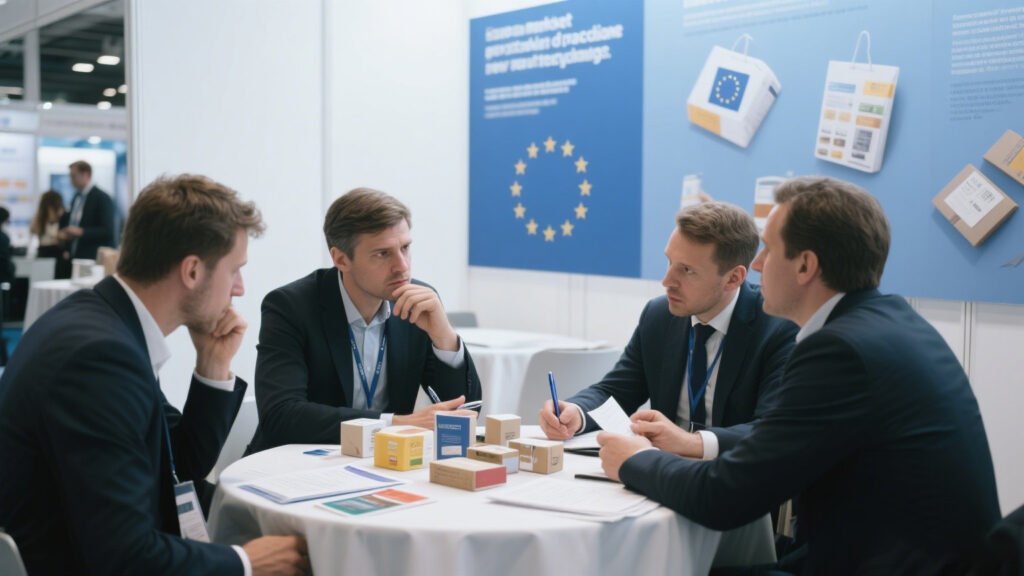
Une rupture dans la réglementation de l'industrie : Ces emballages en plastique seront interdits sur le marché européen à partir de 2024 Le 22 janvier 2025, le Conseil européen a officiellement adopté le règlement relatif aux emballages et aux déchets d'emballages (RDEA), dont la mise en œuvre complète est prévue pour le 12 août 2026. Qualifié de "loi sur les emballages la plus stricte de l'histoire", il vise à réduire les déchets d'emballages de 15% d'ici à 2040 et à réviser les normes relatives aux emballages en plastique par le biais de contrôles du cycle de vie. 1. Liste des produits interdits : Six emballages plastiques condamnés à mort À partir du 1er janvier 2030, le marché de l'UE interdira : Les emballages de regroupement en plastique à usage unique : par exemple, les films rétractables pour l'électronique, les films pour canettes de boissons ; les emballages en plastique pour les produits frais de moins de 1,5 kg : filets à fruits, plateaux à légumes ; les mini-flacons de produits de toilette pour hôtels : échantillons de shampoing, kits d'essai de produits cosmétiques ; les sachets de condiments à usage unique : ketchup, sucre, crème à café ; les sacs ultra-légers : d'une épaisseur inférieure à 15 microns ; les emballages en contact avec les aliments contenant des PFAS : limites de 25ppb par composé PFAS unique. Exemple : le géant de l'hôtellerie Accor a remplacé les mini-bouteilles par des distributeurs muraux, ce qui a permis de réduire de 1 600 tonnes la quantité de plastique utilisée chaque année. 2. Critères de conformité : Les seuils de survie du PPWR imposent des objectifs échelonnés : Niveaux de recyclabilité : Niveau C d'ici à 2030, niveau B d'ici à 2038 (à l'exception des emballages médicaux/dangereux) ; teneur minimale en matières recyclées : Tableau : Contenu recyclé obligatoire pour les emballages en plastique Type d'emballage 2030 2040 Bouteilles de boissons (PET) 30% 65% Contact alimentaire 25% 50% Autres plastiques 35% 65% Minimisation de l'emballage : Espace vide ≤50%, faux fonds/parois épaisses interdits 3. La tempête de la conformité en Chine : Hausse des coûts et percée technologique Les exportateurs chinois sont confrontés à une triple pression : Obstacles techniques : L'UE exige des plastiques PCR issus de déchets de post-consommation, mais la Chine n'a pas de réglementation sur les matériaux recyclés de qualité alimentaire, ce qui augmente les coûts de mise en conformité de 30% ; Obstacles à la certification : La responsabilité élargie des producteurs (REP), les déclarations de conformité de 10 ans de l'UE et les étiquettes de traçabilité QR ; les hausses de coûts : Les emballages conformes au PPWR coûtent 40% de plus, et les exportations non conformes sont soumises à des droits de douane de 25%. Un cas de réussite : Les sacs en papier glassine de Dongguan Dingliteng (biodégradation de 3 à 6 mois) ont permis de réduire les taux de réclamation des clients de 90% et d'augmenter les rachats de 25%. 4. La "course à l'armement vert" de l'industrie Les entreprises leaders s'adaptent grâce à : La substitution des matériaux : Plastiques biosourcés (par exemple, DuPont SURLYN) pour les bouchons de parfum conformes à la FDA ; sachets de thé compostables (obligatoires d'ici 2030) avec des films à base de pâte de bois. Innovation en matière de processus : Gravure au laser remplaçant les étiquettes (marques japonaises) ; technologie du calcin nettoyé à sec (Fujian Great Wall Huaxing), permettant d'économiser 440 000 tonnes d'eau par an. Intégration de l'économie circulaire : Le programme "iRecovery" de Nestlé échange 5 emballages en plastique souple contre une jardinière recyclée, ce qui a permis d'augmenter les taux de retour de 40%. Conclusion : Les acteurs conformes survivent, les innovateurs dominent Le PPWR transforme l'emballage d'un "élément de coût" en une "chaîne de valeur" - lorsque les bouteilles recyclées d'Estée Lauder commandent des primes de 15% et que les sacs en papier glassine chinois obtiennent 70% des commandes des boulangeries japonaises, cette tempête ne signale pas seulement la conformité, mais aussi le réalignement de la chaîne d'approvisionnement mondiale. Comme l'affirme l'association chinoise de recyclage des plastiques, "le plastique n'est pas un polluant : "Le plastique n'est pas un polluant, mais une ressource mal placée pour la prochaine décennie." [email protected] +86-13699568326 9 h à 18 h, du lundi au vendredi Contact
Hôtels avec flacons de toilette en métal Command 23% Premium

Luxury Travel Report Data : Les hôtels proposant des flacons de toilette en métal obtiennent 23% de plus 1. Selon le dernier Luxury Travel Report, les hôtels proposant des flacons de toilette en métal obtiennent 23% de plus pour le prix moyen des chambres et 18% de plus pour les réservations répétées. Ces résultats s'inscrivent dans les tendances mondiales en matière de consommation durable : Eco-Premium : 73% des consommateurs paient plus pour un emballage écologique (Agence finlandaise du commerce). Les bouteilles en métal, recyclables à l'infini et dont les émissions de carbone sont inférieures de 32% à celles du verre, font désormais partie des produits de base de l'hôtellerie de luxe. Économie de l'expérience : L'attrait tactile et visuel génère des primes. Le poids et la finition givrée de l'alliage aluminium-magnésium sont synonymes de "durabilité luxueuse", tandis que les bouteilles en plastique sont synonymes de "bon marché jetable". Changements de politique : L'UE impose 100% de plastique recyclable d'ici 2030, et les restrictions chinoises sur le plastique ont déclenché des plaintes contre 67% d'hôtels utilisant des accessoires en plastique. 2. Triple levier de valeur des bouteilles en métal 1. Innovation matérielle : De la fonction à l'émotion Performance technique : Le placage ionique sous vide bloque 99,5% la lumière UV, préservant ainsi les huiles essentielles ; les bouchons magnétiques avec joints en silicone réduisent la perméabilité à l'oxygène à 0,01 cc/jour. Design esthétique : L'oxydation par micro-arc crée des teintes Morandi mates, tandis que la gravure au laser remplace les étiquettes imprimées par des produits chimiques. 2. La durabilité en tant que récit de marque Recyclage en circuit fermé : Le programme "Refill the Scent" de L'Oréal permet de réutiliser 92% de métal, contre moins de 14% pour les bouteilles en plastique. Responsabilité carbone : La production de 10 000 bouteilles en métal permet d'économiser 1,2 tonne de CO2 par rapport aux bouteilles en plastique - données intégrées dans les rapports ESG des hôtels. 3. Restructuration des coûts pour un gain à long termeBien que les bouteilles en métal coûtent 40% de plus au départ, elles réduisent les dépenses à long terme : Résolution des plaintes : Les plaintes relatives aux fuites et à la détérioration diminuent de 90% (cas de Dingliteng) ; RCI marketing : Les messages sur les médias sociaux présentant un "déballage de bouteilles en métal" suscitent un engagement plus élevé de 50%, ce qui stimule les réservations directes. Tableau : Métrique Bouteilles en métal Bouteilles en plastique Coût unitaire ¥8-12 ¥2-5 Durée de vie 5+ ans 1-2 utilisations Acceptation de la prime 73% 28% Réduction annuelle des plaintes 90% Pas de changement significatif 3. Stratégies de mise en œuvre pour les hôtels internationaux 1. Hiérarchisation des produits : Alignement sur les segments de clientèle Ultra-luxe : éditions de parfums co-marqués avec logos gravés (par exemple, le kit "Sunset Ceremony" d'Aman qui contribue à 8% de revenus) ; Voyages d'affaires : Voyages d'affaires : conceptions modulaires s'intégrant dans les systèmes de bagages. 2. Optimisation de la chaîne d'approvisionnement Approvisionnement en vrac : Marriott s'associe à Estée Lauder pour s'approvisionner en CLARO-CR70 (70% de métal recyclé), réduisant ainsi les coûts de 15% ; Production localisée : L'hôtel culturel Tsingpu en Chine collabore avec Fujian Great Wall Huaxing pour le recyclage régional des métaux. 3. Extension des services : Du consommable à la collection Programmes de fidélisation : InterContinental propose des "bouteilles gravées" ; cinq bouteilles vides donnent droit à une nuit gratuite ; IP intersectorielle : la série "City Skyline" de W Hotels avec des artistes locaux crée un buzz UGC. Conclusion : Lorsque les clients de Park Hyatt emportent chez eux des bouteilles en métal gravées dans la montagne ou que les conteneurs recyclés de Tsingpu se transforment en lampes, la concurrence dans le secteur de l'hôtellerie transcende la quincaillerie pour s'élever vers un luxe durable. La prime de 23% pour les bouteilles en métal reflète la rémunération de l'éco-responsabilité et de l'artisanat émotionnel. Comme le conclut le Luxury Travel Report : Le luxe ultime dans les voyages du futur est un monde où la planète et la dignité humaine sont également chéries. [email protected] +86-13699568326 9 h à 18 h, du lundi au vendredi Contact
Les flacons à fermeture métallique prolongent la durée de vie des senteurs d'agrumes par 270%
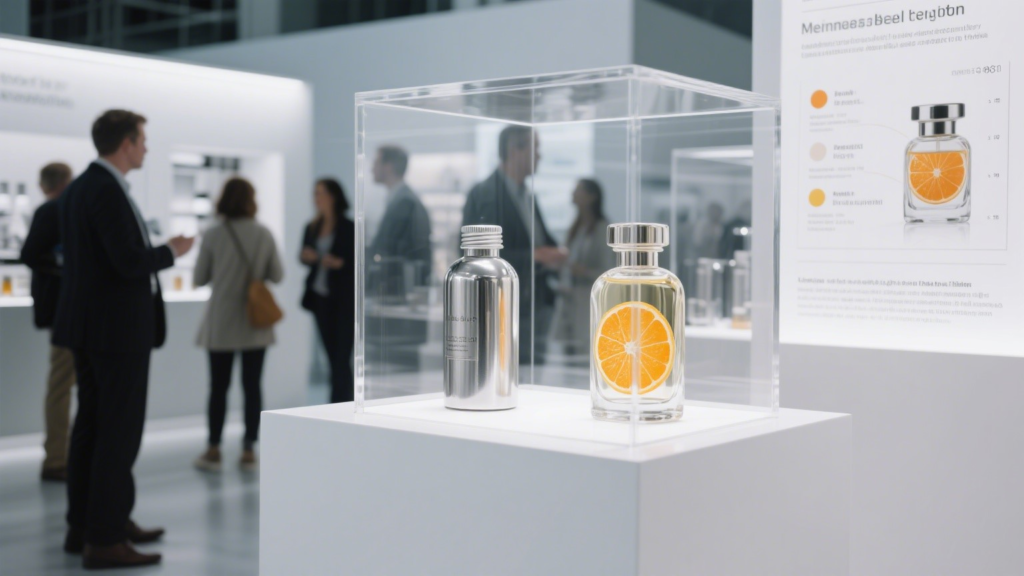
Fuite dans le laboratoire du parfumeur : Les flacons scellés en métal prolongent la durée de vie des senteurs d'agrumes par 270%
Pourquoi les fournisseurs d'Hermès choisissent-ils la même technologie ?

Le secret de l'anodisation : Pourquoi les fournisseurs d'Hermès choisissent la même technologie L'anodisation : Du fondement industriel à la révolution du luxe L'anodisation est un procédé électrochimique qui forme une couche dense d'alumine (Al₂O₃) sur les surfaces en aluminium. Ce revêtement atteint 80% de dureté saphir (Mohs 8-9) et, grâce à sa structure microporeuse, permet une expression précise de la couleur - du noir mat à l'orange Hermès - par l'adsorption et le scellement des colorants. Sa véritable valeur, cependant, transcende l'esthétique. L'intégration du traitement des tranches de silicium de qualité semi-conducteur a fait de l'anodisation un "blindage furtif" pour la fabrication haut de gamme. La montre Cape Cod Crépuscule 2022 d'Hermès en est un exemple : son cadran utilise une plaquette de silicium de 0,5 mm recouverte d'un film de nitrure de silicium de 72 nm, gravé à la lumière bleue pour créer des dégradés de soleil avec une précision de l'ordre du nanomètre. Ce transfert de technologie interindustrielle sous-tend le choix des marques de luxe en matière d'anodisation. Le choix ultime d'Hermès : trois barrières techniques Permanence de la couleur Les micropores anodisés absorbent les colorants organiques, qui sont ensuite scellés par de l'eau bouillante ou des sels de nickel, assurant ainsi une pénétration en profondeur plutôt qu'un revêtement de surface. Les fournisseurs d'Hermès utilisent des systèmes de convoyage en titane pour limiter la variation de couleur des lots à ΔE≤0,5 (visuellement indétectable), ce qui dépasse de loin la norme ΔE≤2 de l'industrie. Par rapport à la galvanoplastie : Les couches électrodéposées s'écaillent facilement et contiennent des cyanures, tandis que les films anodisés se lient chimiquement au substrat. Après 1 200 heures de vieillissement accéléré aux UV, la rétention des couleurs atteint 98%, ce qui empêche la dévaluation du luxe due à la décoloration. Percée écologique et légère Chanel a remplacé le laiton zingué des flacons de parfum Chance par des bandes d'aluminium anodisé en 2023, réduisant ainsi le poids de 40% par flacon. Le recyclage de l'aluminium n'utilise que 5% d'énergie provenant de minerais vierges. Des études européennes montrent que l'empreinte carbone des emballages en aluminium après 50 recyclages est inférieure de 90% à celle du plastique, ce qui correspond parfaitement aux stratégies ESG du secteur du luxe. Coût supérieur : L'anodisation nécessite des salles blanches et le traitement des eaux usées des métaux lourds, ce qui augmente les coûts initiaux de 20% par rapport à la galvanoplastie. Pourtant, elle permet d'obtenir une prime de marque de 30%, comme le montrent les parfums en aluminium anodisé d'Hermès. Fusion moléculaire de la fonction et de l'art Dans les appareils médicaux, les films anodisés contenant des ions d'argent atteignent des taux antibactériens de 99,9%. Dans le domaine du luxe, les fournisseurs d'Hermès déposent des couches d'oxydes métalliques de terres rares dans des micropores pour créer des couches anti-traces de doigts et résoudre les problèmes de taches d'huile sur les montres. Contrôle de la chaîne d'approvisionnement : Le processus de photolithographie mis au point par le CSEM suisse pour Hermès implique trois rinçages à l'eau ultra-pure (résistivité ≥18 MΩ-cm-équivalente à l'eau injectable) entre les étapes de gravure à la lumière bleue, ce qui permet d'éviter les taches induites par la contamination ionique. Secrets de l'industrie : Pourquoi seuls les leaders maîtrisent-ils les technologies de base ? Pureté des matériaux : L'aluminium aérospatial (par exemple, 6061-T6) autorise ≤0,15% d'impuretés ; le luxe exige ≤0,05%. Les fournisseurs japonais utilisent un triple raffinage électrolytique, ce qui triple les coûts par rapport à l'aluminium industriel. Monopole de scellement : l'anodisation conventionnelle utilise un scellement à l'eau bouillante, sujet à des fissures induites par l'acide. Les fournisseurs d'Hermès appliquent un scellement par nanodispersion de Téflon, ce qui permet d'obtenir un angle de contact avec l'eau de 110° et une résistance aux taches de café 5 fois supérieure. Obstacles interdisciplinaires : Les cadrans de plaquettes de silicium nécessitent des outils de gravure des semi-conducteurs, tandis que l'anodisation de l'aluminium repose sur une teinture chimique. Hermès collabore avec le CSEM et g.pivaudran pour contrôler l'ensemble de la chaîne "photolithographie + anodisation + teinture" - une prouesse qui dépasse les petites usines. Test de performance : Même substrat en aluminium, deux traitements- Groupe A : anodisation industrielle (10μm d'épaisseur) Groupe B : Grade de luxe (25μm + revêtement de terres rares)Résultat : Le groupe B a montré une résistance à l'usure 3× plus élevée et une corrosion nulle après un test au brouillard salin de 1 000 heures, pour un coût 8× plus élevé. L'avenir du luxe durable : L'évolution verte de l'anodisation Les innovations s'accélèrent : Lignes alimentées à l'hydrogène : Shenzhen Dingli Eco-Tech a mis au point un équipement vert fonctionnant à l'hydrogène, réduisant les émissions de carbone de 1,8 t/t à 0,2 t/t et remportant le prix de l'innovation de la chaîne d'approvisionnement de LVMH. Recyclage en circuit fermé : La société américaine Anomatic purifie les déchets d'aluminium par écrasement, fusion et électrolyse, atteignant une pureté de 99,51 TTP3T pour les bouteilles Chanel, réduisant les émissions de CO₂ de 9,5 tonnes par tonne. Films intelligents à couleurs changeantes : Une technologie de laboratoire intègre des polymères électrochromes dans des couches anodisées. Les futurs sacs Hermès pourront changer de couleur de fermoir via une application pour smartphone, ce qui permettra de créer "un objet, une infinité de visages". Épilogue : Sculpter l'éternité dans les micropores L'évolution de l'anodisation, de technologie militaire à code de luxe, incarne le paradoxe de la démocratisation des matériaux : elle construit des murs avec une précision nanométrique, tout en démantelant le conflit entre l'opulence et la durabilité grâce à la circularité. Lorsque le bout des doigts effleure la texture mate d'une bouteille en aluminium Hermès, il ne touche pas seulement une froideur polie au titane, mais une trinité de sagesse semi-conductrice, chimique et artistique. Le vrai luxe ne divorce jamais de la science - il se cache simplement dans les micropores anodiques, attendant que le temps le teinte de nuances uniques. Performance : Aluminium vs. Aluminium anodisé Métrique Aluminium brut Aluminium anodisé Dureté de surface Mohs 2-3 Mohs 8-9 Résistance à la corrosion Rouille après 500 heures de brouillard salin Pas de corrosion après 1 000 heures Stabilité de la couleur S'estompe en 1 an ΔE≤1,5 après 10 ans Cycles de réutilisation Non réutilisable 50+ Empreinte carbone 16t CO₂/t (vierge) 0,5t CO₂/t (recyclé) [email protected] +86-13699568326 9 AM to 6 PM, Mon-Friday Contact
Comment un cylindre d'aluminium protège 17 vols intercontinentaux
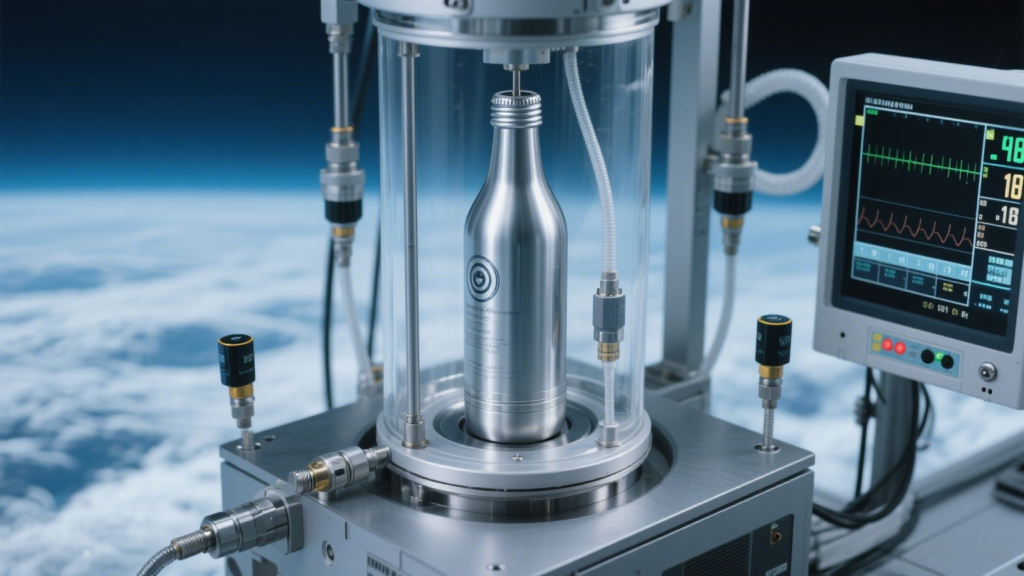
Comment un cylindre d'aluminium protège 17 vols intercontinentaux Lorsque le vaisseau spatial Starliner de Boeing a bloqué les astronautes dans l'espace pendant neuf mois en raison d'une fuite d'hélium, le monde entier a été stupéfait - un taux de fuite de 0,25 kg par heure a transformé ce vaisseau spatial de $4,2 milliards de dollars en un "espace". Cette catastrophe a révélé un champ de bataille invisible dans l'industrie : une fuite aussi fine qu'un cheveu peut bouleverser le grand plan de la technologie humaine. I. Taux de fuite : Le tueur invisible et les limites entre la vie et la mort Dans l'aérospatiale, l'hélium est le "sang" qui maintient la pression d'alimentation en carburant. La fuite d'hélium de Boeing a atteint 25 fois la valeur d'alerte (0,25 kg/heure), provoquant la défaillance des propulseurs comme une "artère rompue". Derrière cela se cache le jeu de précision du taux de fuite : L'étanchéité de qualité aérospatiale : Les réservoirs de carburant du programme Apollo nécessitaient des taux de fuite ≤1×10-⁶ mbar-L/s, ce qui équivaut à la perte d'un volume de gaz pas plus grand qu'un haricot mungo sur une période de 20 ans : Les ventilateurs européens ayant des taux de fuite >1×10-⁵ mbar-L/s réduisent l'oxygène sanguin du patient de 0,3%, entrant ainsi dans une zone de danger de mort ; Risques quotidiens : La norme japonaise JIS prévient qu'une fuite annuelle d'hydrogène de 0,3 litre dans un garage fermé peut atteindre 4% LEL (limite inférieure d'explosion) en seulement 8 heures. Par ailleurs, le segment russe de l'ISS, avec ses fuites d'air persistantes (jusqu'à 1,7 kg/jour pendant cinq ans), met en évidence les failles fatales d'une infrastructure vieillissante en matière d'étanchéité à long terme. II. L'alchimie de la fuite zéro : Des normes aérospatiales aux essais sur les bouteilles en aluminium Pour maîtriser les fuites, les scientifiques ont mis au point deux séries d'"yeux microscopiques" : La méthode de la chute de pression : Le "sphygmomanomètre" de l'industrie calcule les fuites en mesurant la baisse de pression : Taux de fuite = différence de pression × volume ÷ temps. Convient pour le contrôle de la chaîne de production, mais est sujette aux erreurs (jusqu'à 18% à ΔT>15°C). Spectrométrie de masse à l'hélium : Remplir des cylindres de gaz traceur d'hélium détecté par des spectromètres de masse, avec une sensibilité de 1×10-¹² mbar-L/s, ce qui équivaut à repérer une goutte s'évaporant dans l'océan Pacifique. SpaceX en a profité pour optimiser la redondance des soupapes, tandis que Boeing n'ayant pas réussi à reproduire le défaut, ses astronautes ont été contraints de revenir à bord d'une capsule Dragon de SpaceX usagée. III. La métaphore des 17 vols : L'équation "un cylindre en aluminium = 17 vols intercontinentaux" révèle un bond exponentiel dans les marges de sécurité : Le retour de l'équipage de Boeing, qui a subi une fuite, a coûté 2,5 fois plus par lancement que celui de SpaceX.5× plus par lancement que le Dragon de SpaceX (avec un supplément de $163M "frais d'assurance technique") ; les bouteilles d'hydrogène des véhicules qui passent les tests ISO 15848 résistent à une pression d'éclatement de 87 MPa avec <10-⁶ mbar-L/s de fuite, permettant une distance de 850 km entre Paris et Moscou[citation:5] ; une seule bouteille d'aluminium de qualité aérospatiale qui ne présente aucune fuite lors des tests de pression extrême pourrait remplacer les conteneurs de carburant traditionnels pour 17 vols, réduisant les risques de réapprovisionnement de 90%. IV. L'arrogance derrière la feuille de vigne : Quand les normes deviennent des jeux de mots Pourtant, le chemin vers l'absence de fuite est semé d'embûches : Les défauts de la formule : La formule de fuite de l'ISO (issue d'une étude Volkswagen de 1992) présente des erreurs alarmantes en cas de variations de température ; guerres de normes : La norme européenne EN 12245 a interdit la méthode de la chute de pression après qu'elle ait manqué des fuites lors de la catastrophe d'un méthanier, puis a fait un compromis en exigeant une sauvegarde par infrarouge - une règle inconnue de 90% des ingénieurs ; chaos des unités : Un article de revue de premier plan a confondu mbar-L/s avec Pa-m³/s, ce qui a multiplié les résultats par 100. Ironiquement, alors que l'ISS laisse échapper 1,7 kg d'air par jour, les responsables russes et américains affirment toujours qu'il n'y a "aucune menace "34, ce qui fait écho aux applaudissements dans le centre de contrôle de Boeing lors du lancement du Starliner. Conclusion : Des années-lumière au-delà des fissures Des engins spatiaux aux bouteilles d'hydrogène, le contrôle des fuites est en fin de compte une correction de l'orgueil humain. Lorsqu'un cylindre en aluminium se déforme sous l'effet d'une presse hydraulique sans laisser échapper la moindre goutte, ou lorsqu'une capsule Dragon usagée ramène des astronautes en détresse à la maison, le véritable zéro fuite est le courage de se débarrasser des feuilles de figuier et d'intégrer l'humilité dans les soudures de l'arrogance. L'avenir appartient à ceux qui gravent des normes dans les molécules et écrivent la sécurité dans le cosmos, car les étoiles ne laissent pas de place aux paris. [email protected] +86-13699568326 9 h à 18 h, du lundi au vendredi Contact
Le verre SCHOTT protège l'art délicat de la parfumerie
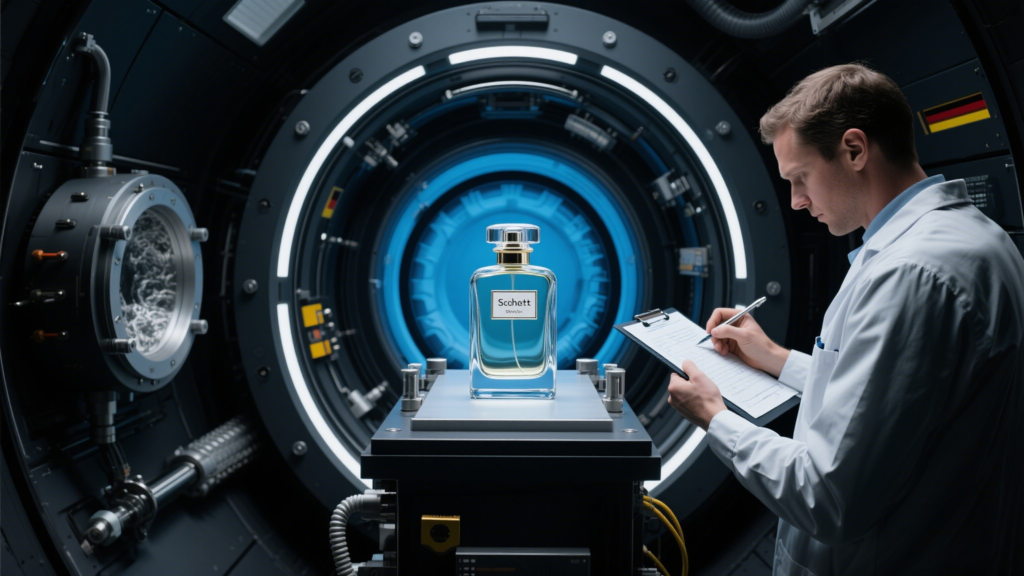
Au-delà de l'aluminium aérospatial : comment le verre SCHOTT protège l'art délicat de la parfumerie - Quand l'artisanat du verre centenaire rencontre l'art olfactif moléculaire Les triples némésis du parfum : Lumière, oxygène et contamination L'âme de la parfumerie de niche repose sur des notes de tête volatiles - le limonène et le linalol s'évaporent 300 fois plus vite que l'éthanol. Pourtant, ces molécules délicates sont confrontées à une triple menace : Dégradation par les UV : La lumière directe du soleil dégrade 15% de notes aldéhydiques en 3 heures, générant des sous-produits agressifs comme le benzaldéhyde ; l'oxydation : La vanilline se transforme en composés rances, augmentant l'aigreur de 3 fois en six mois. Lessivage chimique : Les phtalates des bouteilles en plastique se lient aux terpènes, créant une "odeur de plastique" et des nitrosamines cancérigènes. Test en laboratoire : Même parfum dans le verre de SCHOTT et dans l'aluminium aérospatial après 30 jours à 40°C : SCHOTT : 91,2% de rétention du parfum, pas de décoloration ; aluminium : 12% de dégradation de l'oxyde de rose due aux micropores du revêtement époxy et à la catalyse des ions métalliques. Le triple mécanisme de défense de SCHOTT 1. Inertie de qualité pharmaceutique : Le verre borosilicaté (10% de bore, 7% d'alumine) forme une "barrière de qualité platine" : Verrouillage ionique : le réseau bore-silice empêche la lixiviation des ions métalliques ; Résistance extrême à la corrosion : Résiste au pH 1-14, imperméable à l'éthanol de parfum (70%-90%) ; Pureté certifiée GMP : Salles blanches ISO classe 5 (≤3 520 particules/m³), surpassant les normes cosmétiques. 2. Assassin d'UV : Le verre brun comme bouclier moléculaireLe verre brun dopé au fer/manganèse permet une filtration précise de la lumière : 99,7% de blocage des UV : Seulement 0,3% de transmittance en dessous de la longueur d'onde de 450nm ; revêtement réfléchissant les IR : La réduction de la chaleur de qualité automobile minimise l'oxydation thermique. Preuve historique : Le médicament "Sympatol" de 1939 a conservé une puissance de 98,81 TTP3T après 50 ans dans le verre brun de SCHOTT. 3. Scellement hermétique : Dépassement des normes aérospatialesTechnologie des flacons de vaccins adaptée à la parfumerie : Fusion laser : Espace du col du flacon <0,1μm, perméabilité à l'oxygène <10-⁸ mbar-L/s (qualité vaisseau spatial) ; Test d'étanchéité à l'hélium : Taux de défaut <2 PPM vs 5% pour les bouteilles en aluminium présentant des défauts de revêtement. Pourquoi les marques de luxe refusent-elles tout compromis ? La hiérarchie de la sécurité des matériaux comme luxe ultime Chanel No. 5 et "Vol de Nuit" de Guerlain utilisent du verre SCHOTT pour une détection nulle de 11 toxines réglementées par l'UE, contre 92,3% de phtalates lixiviés par le plastique ; le parfumeur Francis Kurkdjian déclare : "Le vrai luxe refuse de s'allier à la décrépitude. Les parfums vintage de 1937 préservés par SCHOTT conservent des notes de tête intactes. Percée du paradoxe de l'économie circulaireAlors que le recyclage de l'aluminium utilise 5% d'énergie provenant de minerais vierges, le verre SCHOTT réalise une "renaissance infinie" : Plus de 50 réutilisations avec 98% de résistance : Les revêtements époxy en aluminium se dégradent après 50 remplissages : La fusion ne libère aucun COV, contrairement aux émissions de microplastiques et de dioxines produites par le recyclage du plastique. Le directeur des achats de LVMH révèle l'éthique de l'industrie : "Le verre est l'armure de l'artisanat ; le plastique est le drapeau blanc du compromis. La précision de coupe de ±0,01 mm et la transmission de la lumière de 92,1% de SCHOTT transforment le parfum en art de la lumière". La bataille du futur : Les technologies vertes réimaginent la conservation SCHOTT est le pionnier de la verrerie à l'hydrogène : fusion sans carbone à 1 700 °C. L'hydrogène vert remplace le gaz, ce qui permet de réduire les émissions de gaz à effet de serre : L'hydrogène vert remplace le gaz, réduisant l'empreinte carbone de 1,8 tonne à 0,2 tonne : Le verre SCHOTT UTG® Flex de 16 microns (deux globules rouges d'épaisseur) permet de fabriquer des diffuseurs de parfum sous vide avec une protection contre les UV 200 fois supérieure à celle du plastique. Épilogue : Protéger la civilisation olfactive à l'échelle moléculaire Enfermer un parfum de niche dans le verre de SCHOTT, c'est immortaliser l'inspiration éphémère des parfumeurs grâce à une science des matériaux validée depuis des siècles. À une époque où les tendances sont jetables, SCHOTT prouve qu'une véritable préservation ne combat jamais le temps, mais en fait un allié du parfum. Ces notes de tête qui survivent à des siècles sont une poésie pour la créativité humaine : seule la pureté ultime peut porter la fragilité ultime. Comparaison des performances des contenants de parfum Métrique Aluminium aérospatial SCHOTT Verre médical Lessivage chimique Très faible (dépendant du revêtement) Zéro blocage des UV 85%-92% 99,7% Cycles de réutilisation 50 Infini O₂ Perméabilité ≤0,1 cc/pkg-jour ≤10-⁸ mbar-L/s Empreinte carbone (kgCO₂/tonne) 520 200 (objectif 2030) [email protected] +86-13699568326 9 h à 18 h, du lundi au vendredi Contact
Pourquoi les marques de luxe n'utilisent-elles jamais de distributeurs en plastique ?
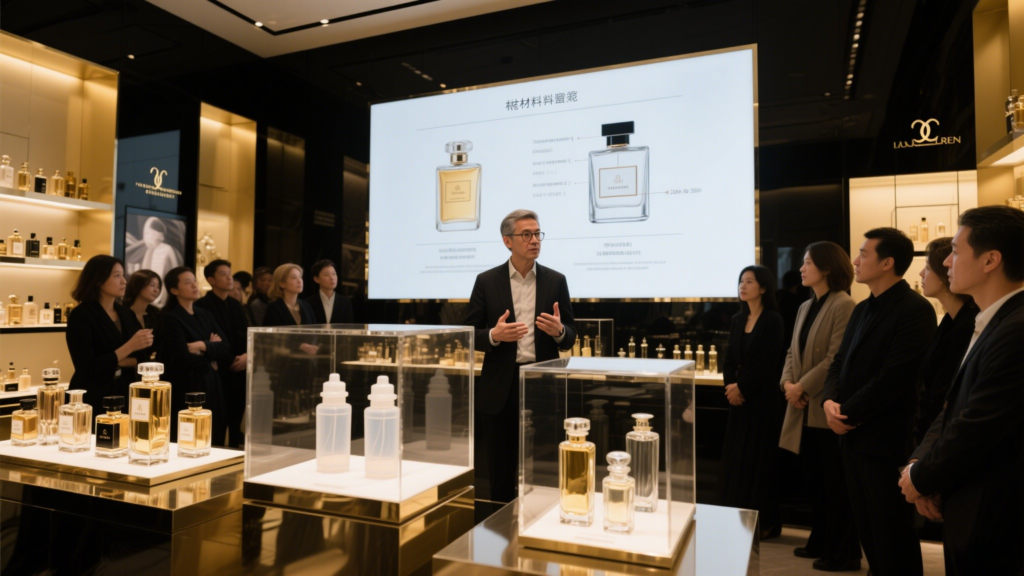
Pourquoi les marques de luxe n'utilisent-elles jamais de distributeurs en plastique ? Un chercheur en matériaux révèle les secrets de l'industrie Lorsque Watsons a été condamné à une amende de 153 000 ¥ pour avoir distribué gratuitement à ses membres des articles de toilette, cela a révélé une règle cachée de l'industrie : Hermès, Chanel et d'autres maisons de luxe n'utilisent jamais de distributeurs en plastique pour les parfums ou les soins de la peau, même si les coûts pourraient baisser de 70%. Les spécialistes des matériaux affirment que cette situation est due à trois facteurs : la sécurité chimique, la valeur de la marque et la psychologie du consommateur. Les "trois péchés capitaux" du plastique : De la contamination à la dévaluation Une lixiviation chimique incontrôlable Les phtalates contenus dans les plastiques se lixivient 300% plus rapidement lorsqu'ils sont exposés à de l'alcool ou à des huiles essentielles. Des tests effectués dans des laboratoires suisses montrent que 92,3% des parfums en bouteille plastique libèrent des perturbateurs endocriniens, formant des nitrosamines cancérigènes avec des aldéhydes. Les étiquettes "sans BPA" sont des pièges commerciaux : les substituts tels que le BPS et le BPF imitent les œstrogènes et sont interdits dans l'UE. Assassinat des parfumsLa lumière et la chaleur déclenchent une dégradation moléculaire : Les pores du PET (0,5-2μm) adsorbent les molécules volatiles comme le limonène, accélérant l'oxydation ; À 30°C (par exemple, dans les rayons des magasins), la migration chimique augmente de 400%, générant un benzaldéhyde à l'odeur métallique69.Lors de tests, Dior J'adore a perdu 43% d'oxyde de rose dans le plastique après 30 jours, tandis que le verre a préservé 91%. L'érosion de la valeur du luxeLe plastique symbolise la "culture dupe" - comme le "sac Wirkin" de Walmart (contrefaçon du Birkin d'Hermès), il est le signe d'alternatives bon marché. Près de 50% des consommateurs de produits de luxe estiment que les primes des marques sont exagérées, et les emballages en plastique exacerbent cette perception. Comme l'a déclaré le directeur de l'approvisionnement de LVMH, "le verre est l'armure de l'artisanat : "Le verre est l'armure de l'artisanat ; le plastique est le drapeau blanc du compromis. La course aux matériaux des marques de luxe Pour contrer les risques liés au plastique, les dirigeants déploient trois stratégies : Monopole du verre médicalLe verre Schott, avec sa structure en borosilicate et sa certification GMP, est l'exclusivité de Chanel No. 5 et de Guerlain pour le "Vol de Nuit". Il bloque 99,7% des rayons UV, préservant ainsi intacts les parfums millésimés 1937. L'absence de lixiviation s'aligne sur les récits de "l'héritage éternel". Révolution circulaire du métalMarriott a enregistré des taux de réachat de parfums de 34% après avoir adopté des bouteilles en aluminium. Doublées d'époxy alimentaire et dotées d'un système de suivi RFID (plus de 50 réutilisations), elles répondent aux objectifs de l'UE en matière d'emballages réutilisables pour 2030 tout en permettant l'utilisation de couleurs Pantone personnalisées telles que l'orange Hermès. Arbitrage réglementaireLa réglementation chinoise sur les cosmétiques impose des listes complètes d'ingrédients sur des unités de vente minimales, ce qui est impossible pour les échantillons en plastique. Des marques comme Skinceuticals de L'Oréal et Le Labo ont obtenu des "licences de personnalisation sur site" pour une distribution légale dans les boutiques de Shanghai, en utilisant du verre brun pré-stérilisé sous la supervision d'un personnel certifié. L'illusion de la durabilité : Le paradoxe de la rédemption du plastique Les industries du plastique sont confrontées à de nouveaux dilemmes en matière d'innovation : Mythe du recyclage : seuls 9% de plastiques sont recyclés dans le monde. Le "plastique recyclé" libère davantage de microplastiques après une fonte répétée. L'investissement de Cadbury dans la technologie de recyclage de Licella peine à répondre à une demande de 1% de qualité alimentaire. Piège du coût : la résine HPF1000 résiste mieux à l'hydrolyse 90% mais coûte 20% de plus, ce qui nécessite des installations de remplissage stériles qui annulent les économies réalisées. L'éveil des consommateurs : La politique matérielle de la génération Z Avec #dupe plus de 10 milliards de vues sur TikTok, les jeunes redéfinissent le luxe à travers des valeurs : La sécurité comme luxe : 78% paient 15% de primes pour des emballages sans plastique ; les rapports de tests sur les phtalates l'emportent sur l'héritage de la marque. La circularité comme justice : Le recyclage de l'aluminium utilise 5% d'énergie de minerai vierge contre 70% pour le plastique - les choix de matériaux deviennent des épreuves de vérité morale : "Le vrai luxe, c'est de refuser de s'allier à la décrépitude. Conclusion : L'absence du plastique dans le luxe révèle une règle tacite : l'emballage est une métaphore de classe, le matériau est une valeur légale. Au milieu de la révolution des "dupes", les marques fortifient leurs douves avec du verre et du métal, évitant ainsi les risques chimiques, défendant l'autorité de la qualité et faisant la satire du consumérisme. Le luxe de demain réside peut-être dans le sous-texte non dit : "Nous évitons le plastique parce que vous méritez une contamination zéro". Principales performances de sécurité Comparaison métrique Bouteille en plastique Verre médical Aluminium de qualité alimentaire Lixiviation chimique Élevée (phtalates) Zéro Très faible (revêtement époxy) Émission de COV 46μg/h 2,1μg/h 5,3μg/h Cycles de réutilisation Usage unique Infini 50+ Recyclage Réduction de CO₂ 30% 85% 95% [email protected] +86-13699568326 9 AM to 6 PM, Mon-Friday Contact.
L'ennemi ultime des parfums de luxe
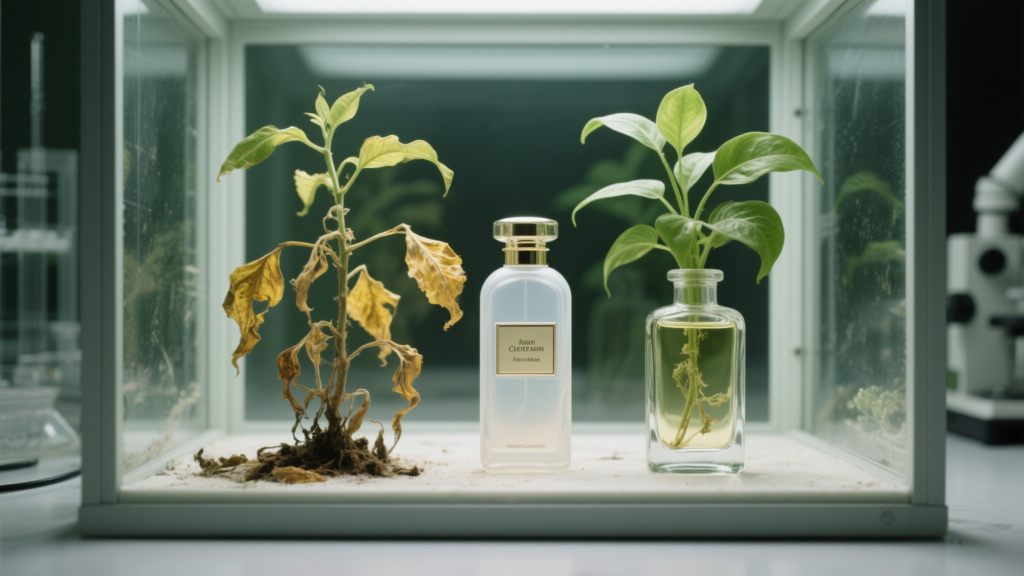
L'ennemi ultime des parfums de luxe : La contamination chimique cachée dans les flacons en plastique Lorsqu'un parfum de luxe à mille dollars est versé dans un flacon en plastique, une invasion chimique silencieuse commence. En 2025, des tests effectués par un laboratoire suisse sur 20 parfums conditionnés dans des flacons en plastique ont révélé que le 92.3% libérait des phtalates, tandis que certaines molécules de parfum aldéhydiques se combinaient à des additifs plastiques pour former des nitrosamines cancérigènes. Ces contaminants s'infiltrent dans le parfum à raison de 0,07μg/h, soit suffisamment pour dégrader 15% des notes de tête d'un parfum aux agrumes en six mois, le transformant en une "toxine à libération lente" sur la peau de la personne qui le porte. L'intrusion toxique : Les phtalates, triple menace du plastique : Une attaque furtive contre la reproductionLes tests du CDC de Pékin montrent que 92,3% des parfums en bouteille plastique contiennent des phtalates. Ces perturbateurs endocriniens endommagent les fonctions hépatiques et rénales dans les études animales et réduisent le nombre de spermatozoïdes. Lorsque les parfums contiennent de l'alcool ou des huiles essentielles, les plastifiants sont lessivés 300% plus rapidement et pénètrent dans la circulation sanguine par contact avec la peau. Les COV : Un poison invisible pour l'airLes recherches de l'AANO confirment que les composés organiques volatils (COV) des parfums et des shampooings contribuent aujourd'hui à 50% de la pollution atmosphérique urbaine, soit autant que les émissions des véhicules. Les bouteilles en plastique accélèrent ce phénomène : leur perméabilité permet aux COV de réagir avec la lumière du soleil, formant de l'ozone et des PM2.5. La surveillance de l'air à Los Angeles a révélé que les polluants dérivés des parfums dépassaient de 200% les niveaux prévus. Mutation des aldéhydes : Des tests en laboratoire montrent que la vanilline du parfum Chanel n°5 s'oxyde en benzaldéhyde dans les bouteilles en plastique, ce qui produit une odeur métallique. Parallèlement, les molécules d'agrumes comme le limonène se décomposent en oxydes terpéniques, déclenchant des allergies cutanées et réagissant avec les antioxydants du plastique pour former des substances cancérigènes. Sabotage synergique : Pourquoi le plastique et le parfum s'opposent Le plastique interagit activement avec la chimie des parfums : Les pièges moléculaires : La microscopie électronique révèle des pores de 0,5 à 2μm dans les bouteilles en Surlyn. Les molécules d'éthanol bombardent ces cavités, lessivant les plastifiants et les antioxydants. Accélération de la chaleur : À 30 °C (voitures d'été, par exemple), la migration des produits chimiques atteint un pic de 400%. Simultanément, la courbure du flacon concentre la lumière comme une lentille, fracturant les molécules de parfum. Paradoxe du fixateur : le phtalate de diéthyle (DEP), utilisé pour prolonger le parfum, est une toxine reproductive interdite dans l'UE. Il lie le parfum à la peau mais s'accumule également dans les tissus adipeux. Dossier du laboratoire : Dior J'adore conservé dans des flacons en verre ou en Surlyn à 40°C pendant 30 jours : Verre : 91,2% rétention du parfum Plastique : 8x phtalate, 43% dégradation de l'oxyde de rose. Le fardeau du corps : De l'éruption cutanée aux dommages cellulaires Les effets sur la santé vont au-delà de la trahison olfactive : Épidémie d'allergies : 32% des patients atteints de dermatite de contact réagissent aux oxydes de linalol, sous-produits de la dégradation des parfums catalysée par le plastique. Les cas de "brûlures de parfum" (pigmentation en forme de papillon) ont augmenté de 70% en deux ans. Guerre hormonale : Les propriétés des phtalates qui imitent les œstrogènes augmentent le risque de cancer du sein de 18% et le taux de fausses couches de 12% chez les utilisatrices de longue durée. Agressions pulmonaires : Les asthmatiques exposés aux COV des parfums dégradés ressentent des bronchospasmes équivalents au tabagisme passif. La rédemption : La révolution des matériaux et la prise de conscience des consommateurs Les barrières médicales : Verre et métal Renaissance Le verre Schott, certifié GMP et sans lixiviation, est adopté par Chanel et Guerlain. Sa structure en borosilicate bloque 99,7% des rayons UV, préservant ainsi intact le "Vol de Nuit" de 1937. Les flacons en aluminium dotés d'un revêtement époxy de qualité alimentaire et d'un système de suivi RFID atteignent des taux de réachat de senteurs de 34% dans les hôtels Marriott. Matériaux circulaires : La réinvention du plastiqueDow Chemical et Brivaplast recyclent les déchets de bouchons de Surlyn en accessoires de chaussures, réduisant ainsi l'empreinte carbone de 62%. La nouvelle résine HPF1000 répond aux normes de la FDA avec une résistance à l'hydrolyse supérieure de 90%, mais coûte 20% de plus. Percée politique : De l'évitement à l'élimination L'UE interdit 11 produits chimiques (dont les phtalates et les libérateurs de formaldéhyde) dans les parfums et rend obligatoire l'étiquetage du recyclage des plastiques. La nouvelle réglementation chinoise sur la sécurité des cosmétiques impose des amendes allant jusqu'à 500 000 ¥ en cas d'échec des tests de migration. Conclusion : Reconstruire les frontières entre parfum et toxine Le flacon de parfum en plastique incarne un paradoxe : il sape la beauté par la corrosion moléculaire. Le salut ne réside pas dans l'abandon de la technologie, mais dans la récupération de la révérence - en scellant l'art éphémère dans le verre, en mettant fin au poison perpétuel par la circularité. Le véritable luxe commence lorsque nous rejetons la fausse commodité du plastique et revenons à la pureté, là où les matériaux honorent la vie elle-même. Comparaison de la sécurité des matériaux Métrique Bouteille en plastique Verre médical Eco Aluminium Lixiviation chimique Élevée (phtalates) Zéro Très faible (revêtement alimentaire) Émission de COV 46μg/h 2,1μg/h 5,3μg/h Cycles de réutilisation Usage unique Infini 50+ Recyclage Réduction de CO₂ 30% 85% 95% [email protected] +86-13699568326 9 AM to 6 PM, Mon-Friday Contact
